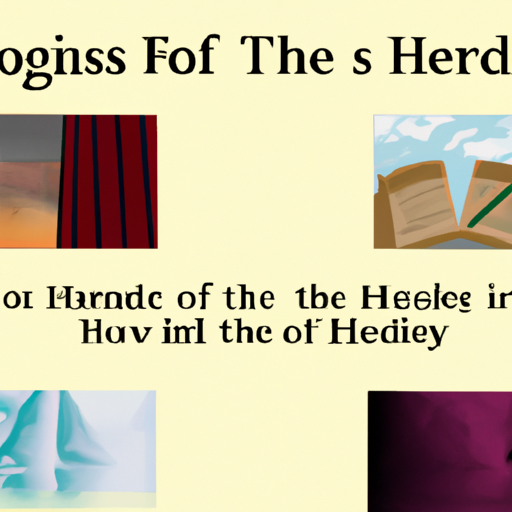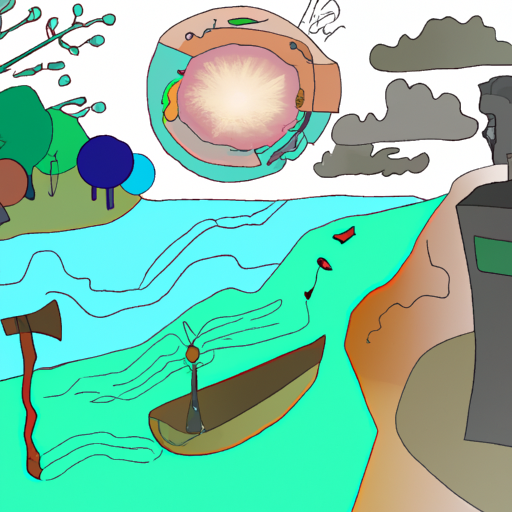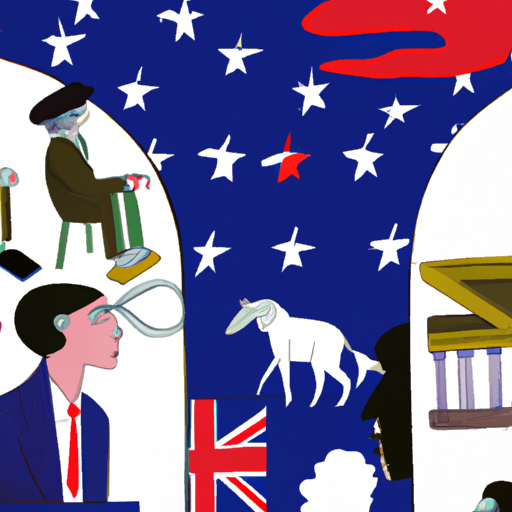History of the Oldest Language on Earth
Unearth the hidden mysteries of days gone by and unveil the oldest language known to humankind! Embark on a journey of exploration, uncovering secrets that have long been forgotten and traversing through time. Uncover the evidence of ancient civilizations and explore the depths of an age-old language. Find out what lies beneath and discover a past that has never before been revealed.

A journey through time, a voyage of discovery! Uncovering secrets that have long been hidden, delving into the depths of history to explore the past. Tales of our ancestors, customs and beliefs that were once thought to be lost forever… But now we can uncover them! With research and exploration, there is much to be discovered – ancient civilizations, the oldest language known to humankind. All waiting for us to uncover their mysteries and gain a better understanding of our own culture. So come with us on this journey through time as we unravel the mysteries of history!
.
Introduction

What is the oldest language on Earth? It’s a question that has perplexed historians for centuries. Could it have been spoken by Homo sapiens, who lived in Africa around 50,000 years ago? Was it just a series of grunts and gestures used to communicate basic needs and desires? Or did it evolve into something more complex over time, with distinct grammar, phonology and syntax? The answers remain unclear. We know that written language began around 5,000-6,000 BC with Sumerian cuneiform script. From there we saw the emergence of Akkadian, Egyptian hieroglyphs, Greek, Latin and Sanskrit throughout the ancient world. Even today these languages can still be heard in some form or another across the globe.
– The History of the Oldest Language on Earth
The ancientness of the oldest language on Earth is a remarkable story, dating back to the dawn of humanity when our forebears first began communicating. This language has been passed down in various forms throughout the ages, and is still spoken by some people today.
Sumerian is thought to be the earliest known language, used in present-day Iraq around 4500 BC. It was employed for writing and had many dialects that were utilized across Mesopotamia. It eventually progressed into Akkadian, a Semitic language which was commonly used in the Middle East from 2000 BC until it became extinct in the 1st century AD.
Sanskrit also originated in India around 1500 BC and has had a lasting impact on numerous languages, including English and Hindi. This Indo-European language was used for religious texts and literature as well as scientific works such as mathematics and astronomy.
Basque is believed to be the oldest living language existing today; it has been spoken in parts of Spain and France since at least 1000 BC. Other surviving languages include Hebrew, Aramaic, Latin and Ancient Greek—all of which have left an indelible imprint on modern tongues worldwide.
It’s amazing to think about how far back our heritage extends—and how much of it still reverberates today! From Sumerian to Sanskrit to Basque, these oldest languages are a tribute to our collective past—and an indication that we all come from somewhere.
– Ancient Languages and their Historical Impact
Mysteriously, languages of antiquity have had an immense effect on our world’s history. From the archaic Sumerian cuneiform to the hieroglyphs of Ancient Egypt, these tongues have been used to store and protect historic events for thousands of years. They were also employed to communicate between cultures, allowing them to share beliefs and customs. Examining ancient languages can give us a valuable window into the past and assist us in comprehending how different societies interacted in their era.
The earliest known written language is Sumerian cuneiform, tracing back to around 3200 BCE. This writing system was utilized by Mesopotamians for more than 3000 years until it was superseded by Aramaic in the 7th century BCE. Cuneiform was applied for varied purposes such as recording laws, religious texts, and commercial transactions. It was also used to record significant historical occurrences such as battles and conquests.
The ancient Egyptians developed their own writing system called hieroglyphs circa 3000 BCE. Hieroglyphs were mainly used for spiritual or magical purposes but they were likewise utilized to document important events like coronations or military triumphs. The Rosetta Stone is perhaps one of the most renowned examples of hieroglyphic writing since it provided researchers with a key to understanding other ancient Egyptian texts that had previously been indecipherable.
The Ancient Greeks formulated their own alphabet circa 800 BCE which enabled them to write down their stories, myths, and histories in an orderly manner. This alphabet was adopted by the Romans who disseminated it across Europe during their reign plus influencing many other languages such as Spanish and French.
In addition to granting us with an invaluable source of information about our past, ancient languages have also had a tremendous influence on modern society. Numerous words from Latin and Greek are still frequently used today while some languages such as Sanskrit are still studied in universities around the globe due to their relevance in various fields like philosophy and medicine. By exploring these old tongues we can gain a deeper knowledge not only about our past but also about ourselves in the present day.
– How Language Has Evolved Throughout History
Humankind’s relationship with language is an ancient one, stretching back to the earliest of days. From primitive grunts and gestures to the complex languages we speak now, communication has evolved in ways that are both awe-inspiring and remarkable. As technology and communication methods have changed, so too has the way people interact with each other.
The first traces of language can be found in records from around 100,000 years ago when early Homo sapiens began using simple noises and body language to express themselves. Over time, these basic forms of expression evolved into more intricate systems as humans learned to use symbols to represent objects and ideas – this is known as protolanguage or pidgin languages.
As civilizations grew and spread across the globe, languages did too; during the Middle Ages Latin was dominant in Europe, while Arabic was widely spoken in the Middle East and Asia. The development of writing systems helped spread new languages even further, allowing for greater cultural exchange between different parts of the world.
Fast forward to today: technology has had a huge impact on our ability to communicate with one another – computers and the internet have made it easier than ever for people from all corners of the globe to share information quickly and easily, creating more linguistic diversity than ever before.
Language continues to evolve at a rapid pace in response to our changing needs – as technology advances further still, it is likely that this evolution will only accelerate further in order to keep up with our rapidly changing environment.
– Exploring the Evolutionary Roots of Language Through History
Through the ages, language has been an integral part of human life, and its evolution has been a subject of much curiosity. By delving into the past to trace the origins of language, we can gain insight into how it has shifted and adapted over time.
It is believed that the earliest forms of communication emerged around 35,000 years ago when humans first began to use symbols and abstract concepts in their speech or gestures. As humans continued to evolve, so did their capacity for language, leading to increasingly intricate modes of expression.
Throughout history, languages have undergone changes due to cultural influences and technological advances. For instance, the invention of writing systems allowed for more exact articulation of ideas and concepts; while printing presses enabled wider dissemination of written material which facilitated better communication between people from different regions and backgrounds.
In recent decades, digital technologies have further revolutionized our ability to communicate with each other at lightning speed. Social media platforms such as Twitter and Facebook have made it possible for us to share information instantly across vast distances.
By examining the evolutionary roots of language throughout history, we can gain valuable insights into how it has changed in response to external factors. Moreover, this knowledge can help us comprehend how language will continue to develop as technology progresses at a rapid rate.
– Uncovering the Mysteries of the Oldest Language in Human History
Exploring the ancient past of humanity has long been an enigma, and one of its most captivating puzzles is the oldest language. Despite many theories, the age and origin of this language remains a secret.
Linguists have studied ancient texts, artifacts, and archaeological evidence to uncover clues about the earliest known languages. Sumerian, Akkadian, and Egyptian hieroglyphs are some potential candidates for the title of oldest language; all share similarities that hint at a connection between them.
Surprisingly, some of these ancient languages seem to be related to modern tongues such as English, French, or Spanish. This implies our ancestors spoke these languages thousands of years ago and we can use modern linguistic techniques to understand how they evolved over time.
In addition to examining written records, researchers have also looked at artifacts like pottery shards and tools to gain insight into how people spoke in the past. By analyzing items from different eras, scientists can get an idea of how language changed over time and what kind of words were used by our ancestors thousands of years ago.
The mystery surrounding the oldest language in human history is still unsolved but new pieces are being added every day thanks to linguists’ efforts in studying both written records and archaeological evidence. Slowly but surely they are piecing together a picture of our distant past – one full of stories told through this mysterious tongue.
conclusion

It is postulated that the primordial language of our planet is Proto-Indo-European, purportedly having been voiced as far back as 6,500 BCE. This archaic tongue is believed to have spawned a great many of the languages that are spoken in present times.
.
Some questions with answers
Q1. What is the oldest language on Earth?
A1. The oldest language on Earth is believed to be Sumerian, which dates back to around 3500 BCE.
Q2. How long has Sumerian been in use?
A2. Sumerian has been in use for over 5000 years.
Q3. Is there any evidence of other ancient languages?
A3. Yes, there is evidence of other ancient languages such as Akkadian, Elamite, and Old Persian dating back to around 3000 BCE.
Q4. Is Sumerian still used today?
A4. No, Sumerian is no longer spoken or written today but it has had a significant influence on modern languages such as English and German.
Q5. Where can I find more information about the history of language?
A5. You can find more information about the history of language in books, online articles, and museum exhibits dedicated to the subject.





